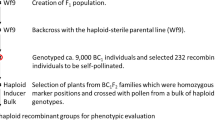Summary
The evidence discussed in this paper demonstrates unuqual genetic contribution of N. debneyi-tabacum and N. longiflora to the development of tumors in hybrids between them. Tumor formation depends upon the presence of a specific longiflora chromosome fragment in an otherwise debneyi-tabacum background and consequently is transmitted as a dominant trait. Tumor expression remains relatively constant among those segregants which carry the complete complements of N. debneyi-tabacum or N. tabacum along with the longiflora chromosome, but tumors fail to develop on plants with a few debneyi chromosomes on a diploid longiflora background. These results suggest that gene(s) on a single longiflora chromosome fragment are sufficient, whereas from N. debneyi or N. tabacum a large number of genes distributed over many chromosomes are required for tumor formation. An hypothesis concerning genetic components controlling tumor initiation (I) and expression (ee) is proposed, supported by these observations, and by previous studies both genetic and physiological, on another tumorous hybrid between N. glauca and N. langsdorffii. (I) and (ee), representing unequal contributions from two evolutionarily diverse species, must both be present in the hybrid for tumors to develop. Evidence is presented to indicate that N. longiflora and N. langsdorffii, belonging to the section Alatae, represent species carrying (I) and that N. debneyi, N. tabacum and N. glauca, belonging to different sections of the genus Nicotiana, are (ee) carriers. It is predicted that genetic analyses will reveal that the genes for tumor initiation (I) will be carried invariably by species of the section Alatae, or the so-called plus group of Näf, and genes modifying expression (ee) by species from other sections but belonging to the so-called minus group. Specific characterization of (I) and (ee) in biochemical terms is under investigation.
Similar content being viewed by others
References
Ahuja, M. R.: A cytogenetic study of heritable tumors in Nicotiana species hybrids. Genetics 47, 865–880 (1962).
—: Genetic control of tumor formation in higher plants. Quart. Rev. Biol. 40, 329–340 (1965).
—: The effects of X-irradiation on seedling tumor production in Nicotiana species and hybrids. Rad. Bot. 3, 55–57 (1963).
—: Morphogenesis in Nicotiana debneyi-tabacum, N. longiflora and their tumor forming hybrid derivatives in vitro. Develop. Biol. 13, 408–423 (1966a).
——: Chromosomes and nutritional requirements of a tumor forming Nicotiana hybrid and its derivatives. Amer. J. Bot. 53, 609 (1966b).
——: Cytogenetics of tumor-bearing interspecific triploid Nicotiana glauca-langsdorfffii and its hybrid derivatives. J. Hered. 58, 103–108 (1967).
Anders, F.: Genetische Faktoren bei der Entstehung von Neoplasmen. Zbl. Vet. Med., B 15, 29–46 (1968).
Bayer, M. H.: Paper chromatography of auxins and inhibitors in Nicotiana glauca, N. langsdorffii and three of their tumor forming hybrids. Planta (Berl.) 72, 329–337 (1967).
—: Tumor formation in Nicotiana: Auxin levels and auxin inhibitors in normal and tumor-prone genotypes. Planta (Berl.) 79, 292–298 (1968).
Hagen, G. L.: Genetic and metabolic problems in tobacco tumor growth and morphogenesis. Proc. Intern. Conf. Plant Tissue Culture, P. R. White (ed.), p. 61–65. Berkeley: McCutchen 1965.
Kehr A. E., and H. H. Smith: Genetic tumors in Nicotiana hybrids. Brookhaven Symp. Biol. 6, 55–78 (1954).
Kostoff, D.: Cytogenetics of the genus Nicotiana. Sofia (Bulgaria): State Printing House 1943.
Moav, R.: Genetic instability in Nicotiana hybrids. II. Studies of the Ws (pbg) locus of N. plumbaginifolia in N. tabacum nuclei. Genetics 46, 1069–1087 (1961).
—: The expression of instability in N. tabacum x N. plumbaginifolia. Amer. J. Bot. 47, 87–93 (1960).
Näf, U.: Studies on tumor formation in Nicotiana hybrids. I. The classification of parents into two etiologically significant groups. Growth 22, 167–180 (1958).
Schaeffer, G. W., and H. H. Smith: Auxin-kinetin interaction in tissue culture of Nicotiana species and tumor conditioned hybrids. Plant Physiol. 38, 291–297 (1963).
Smith, H. H.: Genetic tobacco tumors and the problem of differentiation. Brookhaven Lecture Series. BNL 967 (T-405), p 1–8 (1965).
Smith, H. H.: Recent cytogenetic studies in the genus Nicotiana. Advanc. Genet. (in press).
Zimmermann, F. K., and R. Schwaier: Induction of mitotic gene conversion with nitrous acid, 1-methyl-3-nitro-1-nitrosoguanidine and other alkylating agents in Saccharomyces cervisiae. Molec. Gen. Genetics 100, 63–76 (1967).
Author information
Authors and Affiliations
Additional information
Communicated by H. Stubbe
Rights and permissions
About this article
Cite this article
Ahuja, M.R. An hypothesis and evidence concerning the genetic components controlling tumor formation in Nicotiana . Molec. Gen. Genet. 103, 176–184 (1968). https://doi.org/10.1007/BF00427144
Received:
Issue Date:
DOI: https://doi.org/10.1007/BF00427144




